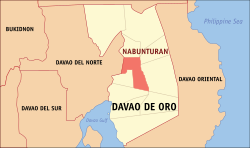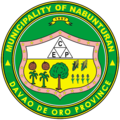Nabunturan | |
|---|---|
| Municipality of Nabunturan | |
Nicknames:
| |
| Motto: Nabunturan, A Progressive, Peaceful, and Dynamic Agri-based Municipality | |
| Anthem: Nabunturan Hymn | |
 Map of Davao de Oro with Nabunturan highlighted | |
 Interactive map of Nabunturan | |
Location within the Philippines | |
| Coordinates: 7°36′12″N125°58′01″E / 7.603414°N 125.967047°E | |
| Country | Philippines |
| Region | Davao Region |
| Province | Davao de Oro |
| District | 2nd district |
| Founded | July 23, 1957 |
| Barangays | 28 (see Barangays) |
| Government | |
| • Type | Sangguniang Bayan |
| • Mayor | Myrocel Clarin-Balili |
| • Vice Mayor | Rodel G. Balili |
| • Representative | Ruwel Peter S. Gonzaga |
| • Electorate | 53,977 voters (2025) |
| Area | |
• Total | 231.30 km2 (89.31 sq mi) |
| Elevation | 127 m (417 ft) |
| Highest elevation | 437 m (1,434 ft) |
| Lowest elevation | 64 m (210 ft) |
| Population (2024 census) [3] | |
• Total | 85,949 |
| • Density | 371.59/km2 (962.42/sq mi) |
| • Households | 20,831 |
| Demonym | Nabunturanon |
| Economy | |
| • Income class | 1st municipal income class |
| • Poverty incidence | 13.7 |
| • Revenue | ₱ 464.6 million (2022) |
| • Assets | ₱ 872.4 million (2022) |
| • Expenditure | ₱ 416.3 million (2022) |
| Service provider | |
| • Electricity | Northern Davao Electric Cooperative (NORDECO) |
| • Water | Nabunturan Water District |
| • Telecommunications | Globe Telecom PLDT |
| • Cable TV | Nabunturan Cable TV Network |
| Time zone | UTC+8 (PST) |
| ZIP code | 8800 |
| PSGC | |
| IDD : area code | +63 (0)87 |
| Native languages | Davawenyo Cebuano Kalagan Mansaka Tagalog Ata Manobo |
| Website | nabunturan |
Nabunturan, officially the Municipality of Nabunturan (Cebuano : Lungsod sa Nabunturan; Tagalog : Bayan ng Nabunturan), is a municipality and capital of the province of Davao de Oro, Philippines. According to the 2020 census, it has a population of 84,340 people. [5]
Contents
- History
- Geography
- Barangays
- Climate
- Demographics
- Economy
- Government
- List of former chief executives
- Media
- Radio stations and cable provider
- References
- External links
The municipality is home to the Mainit Hot Springs Protected Landscape.


